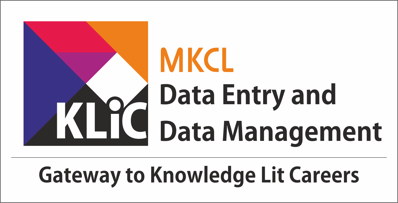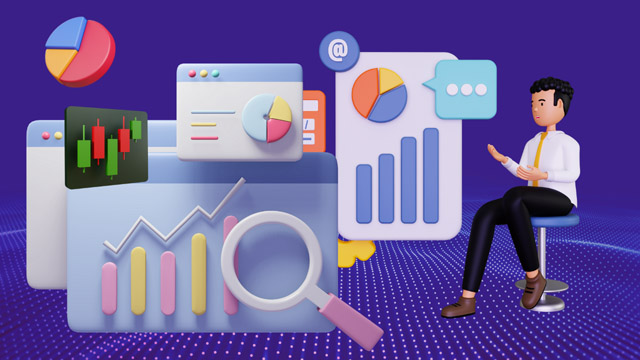- Equip with advanced skills in creating various types of charts in Excel.
- Create comprehensive dashboards in Excel for data visualization and analysis.
- Provide a foundational understanding of Google Analytics and its key features.
- Familiarize with the fundamentals of Google Data Studio for creating compelling visualizations.
- Leverage Google Data Studio for advanced data analytics and visualization.

Data Processing and Reporting
Explore techniques for data collection, processing, and creating effective business reports.
Introduction
What you'll learn ?
- Be proficient in designing and customizing complex charts to effectively represent data.
- Design interactive and insightful dashboards that convey meaningful insights.
- Navigate Google Analytics, interpret data, and generate reports for informed decision-making.
- Use Google Data Studio to design and present data-driven reports and dashboards.
- Perform complex data analyses, create interactive reports, and extract valuable insights using Google Data Studio.
Syllabus
- Apply Custom Formats and Layouts
- Apply Custom Data Formats
- Use Advanced Fill Options
- Apply Advanced Conditional Formatting and Filtering
- Apply Custom Styles and Templates
- Use Form Controls
- Prepare Workbooks for Internationalization
- Use Outlines
- Use Custom Views
- Create advanced formulas
- Functions
- Apply functions in formulas
- Mathematical Functions
- Financial functions
- Useful Data Functions
- Some Other Useful Functions
- Look up data by using functions
- Apply advanced date and time functions
- Functions for Manipulating Text
- Use Scenarios
- Use What-If Analysis Tools
- Create Scenarios
- Merge Scenarios
- Create Scenario Summaries
- Use Data Tables
- Create Advanced Charts
- Basic Excel Charts
- Use Area, Scatter & Stock Charts
- Use Surface, Radar & Combination Charts
- Create Custom Chart Templates
- Details of using Macros
- Record a Macro
- Method of Using Macros
- Creating Program VBA
- Visual Basic Editor (VBA)
- Macros
- Visual Basic Editor
- Remove Formatting
- IF Statement
- For Loop Function
- Introduction
- Input Box
- DoWhile or DoUntil
- Do While
- Do Until
- Transpose Headers
- Transpose Customer Order
- Adding Loop 1
- Adding Loop 2
- Introduction of Pivot Table
- Recommended Pivot Table
- Pivot Table 1
- Pivot Table 2
- Graphs and Charts
- Understand Pivot Table
- SUMPRODUCT Function
- Steps to Compute Net Sales
- SUMIF Function
- COUNTIF Function
- COUNTIFS Function
- AVERAGEIF Function
- Data Validation
- TRUE function
- LOOKUP function
- VLOOKUP function
- HLOOKUP function
- INDEX MATCH function
- What is Goggle Analytics
- Benefits of Goggle Analytics
- How to Setup Goggle Analytics Account
- Hierarchy of the Google Analytic
- Basics of Google Analytic
- Pros and Cons of Google Analytic
- Google Analytics
- Audience report
- Bounce Rate / Audience–Active Users
- Demographics
- Behaviour Overview
- 6 benefits of using Google analytics
- History of Data
- How to Tell A Story With Data & Analytics
- Introduction to Google Data Studio
- Google Data Studio-1
- Google Ads
- Google Analytics-1
- Google Analytics-2
- YouTube Analytics-1
- YouTube Analytics-2
- Creating Tables
- Formatting and Sorting Tables
- Multiple Measures
- Conditional Formatting
- Advantages of using Tables in Google Data Studio
- Practical Activity Completed Tables
- Average value - highest and lowest value
- Completed practical activity
- Comparison calculations
- Running total calculation
- Drill down
- Working with dates
- Create Pivot Table
- Scorecard Visualization
- Practical Activity
- Slicers and Visualisation-1
- Text filter visualization
- Numeric visualization filters
- Date visualization filters
- Custom calculations
- Year month and day
- Case Statement
- Comparisons
- Into to time series graphs
- Create time series graphs1
- Create time series graphs 2
- Create time series graphs 3
- Changing time perolods
- Style and formatting
- Time series chart options
- Area graph
- Introduction to Slicers and visualization filters
- Scorecard visualizations
- Text Slicers
- Numeric slicers
- Date slicers
- Text visualisation filters
- Numeric visualisation filters
- Date visualisation filters
- Column and bar graphs
- Pie graphs
- Custom visualisation
- Analysing Data
- Practical Activity
- Google Data Studio
- Add Visits
- Using Google Data 1
- Using Google Data 2
- Using Google Data 3
- Sharing Dashboards
- Sharing Dashboards 1
- Data studio function for calculated fields
- Concat formula
- "RegExp Extract"
- "RegExp Match"
- "Case" formula
Certificate
- MKCL provides certificate (for 30/60/90 hours courses) to the KLiC learner after his/her successful course completion.
Academic Approach
The Academic Approach of the course focuses on the “work centric” education i.e. begin with work (and not from a book !), derive knowledge from work and apply that knowledge to make the work more wholesome, useful and delightful. The ultimate objective is to empower the Learner to engage in socially useful and productive work. It aims at leading the learner to his/her rewarding career as well as development of the society.
Learning methodology
- Learners are given an overview of the course and its connection to life and work.
- Learners are then exposed to the specific tool(s) used in the course through the various real-life applications of the tool(s).
- Learners are then acquainted with the careers and the hierarchy of roles they can perform at workplaces after attaining increasing levels of mastery over the tool(s).
- Learners are then acquainted with the architecture of the tool or Tool Map so as to appreciate various parts of the tool, their functions and their inter-relations.
- Learners are then exposed to simple application development methodology by using the tool at the beginner’s level
- Learners then perform the differential skills related to the use of the tool to improve the given ready-made outputs.
- Learners are then engaged in appreciation of real-life case studies developed by the experts.
- Learners are then encouraged to proceed from appreciation to imitation of the experts.
- After imitation experience, they are required to improve the expert’s outputs so that they proceed from mere imitation to emulation.
- Finally, they develop the integral skills involving optimal methods and best practices to produce useful outputs right from scratch, publish them in their ePortfolio and thereby proceed from emulation to self-expression.
Evaluation Pattern
Evaluation Pattern of KLiC Courses consists of 4 Sections as per below table:
| Section No. | Section Name | Total Marks | Minimum Passing Marks |
|---|---|---|---|
| 1 | Learning Progression | 25 | 10 |
| 2 | Internal Assessment | 25 | 10 |
| 3 | Final Online Examination | 50 | 20 |
| Total | 100 | 40 | |
| 4 | SUPWs (Socially Useful and Productive Work in form of Assignments) | 5 Assignments | 2 Assignments to be Completed & Uploaded |
MKCL’s KLiC Certificate will be provided to the learner who will satisfy the below criteria:
- Learners who have successfully completed above mentioned 3 Sections i.e. Section 1, Section 2 and Section 3
- Additionally, learner should have completed Section 4 (i.e. Section 4 will comprise of SUPWs i.e. Socially Useful and Productive Work in form of Assignments)
- Learner has to complete and upload minimum 2 out of 5 Assignments
Courses Fee Structure from 01 July, 2025 Onwards
KLiC 30 hour course fee applicable from 01 July, 2025 all over Maharashtra| KLiC Course Duration | MFO: MKCL Share (Including 18% GST) |
ALC Share (Service Charges to be collected by ALC) |
|---|---|---|
| 30 hours | Rs. 300/- | Rs. 1,500/- |
Important Points:
* Above mentioned fee is applicable for all Modes of KLiC Courses offered at Authorised Learning Center (ALC) and at Satellite Center
* Total fee is including of Course fees, Examination fees and Certification fees
* MKCL reserves the right to modify the Fee anytime without any prior notice
* Above mentioned fee is applicable for all Modes of KLiC Courses offered at Authorised Learning Center (ALC) and at Satellite Center
* Total fee is including of Course fees, Examination fees and Certification fees
* MKCL reserves the right to modify the Fee anytime without any prior notice
